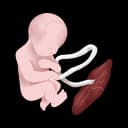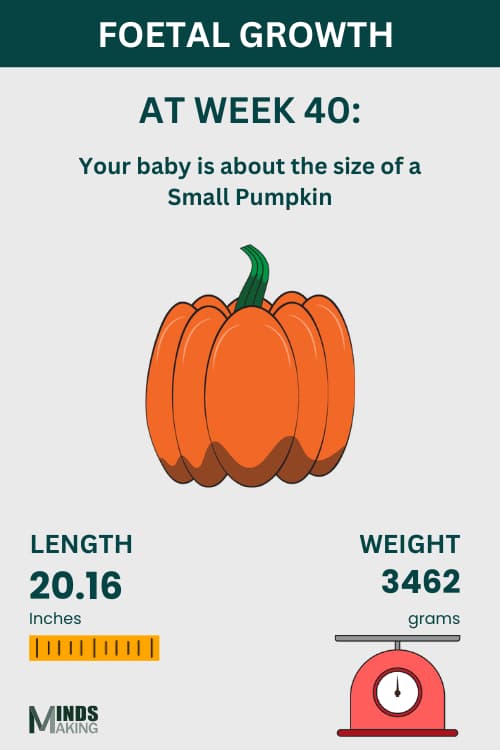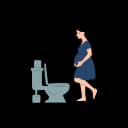Your Pregnancy at Week 40
Science Photo Library

Written by Mindsmaking Medical Writer
Fact Checked by Mindsmaking Professionals
27th, July, 2025
You're at week 40, congratulations, your little one is fully developed and could arrive any day now, so it's an exciting (and nerve-wracking) time. Your baby could arrive any day now!
Your long journey will finally come to an end. You must be expecting your upcoming delivery. It should be time to ensure your phone is always full and ready to call if you need assistance.
Even if you have not given birth yet, you should not be alarmed because a small percentage of children are born in the 41st week or overdue. After all, it could be a miscalculation of the accurate time of pregnancy.
Most of the time, medical practitioners get the wrong age of your pregnancy because of some information given to them by you, like the last date of your menstrual flow and some other information. But you still need to remember that your baby will arrive anytime.
Key Takeaways
Only about 5% of babies are born on their due date, and it's normal to give birth anywhere from two weeks before to two weeks after.
Your baby measures around 20.16 inches and weighs about 3462 grams, comparable to a pumpkin
You may experience more Braxton Hicks contractions, which are practice contractions that help your body prepare for labour. These are usually mild, irregular, and not painful.
By 40 weeks, your uterus has likely reached its maximum size, growing from about two ounces to around two and a half pounds throughout your pregnancy.
Breaking the amniotic sac and releasing amniotic fluid signifies labour is near. This can happen hours before or during labour and may be experienced as a gush of fluid or a slow trickle.
Contact your doctor immediately at 40 weeks if you have unusual symptoms like severe cramping, decreased baby movements, or bleeding.
Gentle activities like walking can help move things along by encouraging your baby to shift lower, promoting cervical dilation and effacement.
Before you and your partner try any home methods to induce labour, discuss them with your partner's healthcare provider. Many of these methods are not proven and could be unsafe.
To be as prepared as possible for birth, ensure your car has a full tank of petrol or confirm your transportation arrangements.
Take a peek

Soft and flexible Skull Bones
During birth, your baby's head needs to pass through the birth canal, which is a tight space. The skull bones are not fused yet, which allows them to overlap slightly. This overlapping helps the head fit through the canal more easily.

Dry skin
Dry spots may appear on your baby's skin since he has already lost most of his vernix, the cheesy coating that served as a moisturiser.

Due date
Only 5 percent of babies are born on their exact due date. It's normal to give birth between two weeks before and two weeks after the estimated due date, so do not panic if the baby hasn't arrived this week.
Baby Development at Week 40
At 40 weeks pregnant, it's difficult to predict your baby's exact size, but on average, newborns weigh around 3.5 kg and measure over 21 inches in length. By this stage, most of the vernix (the protective coating on the baby's skin) has disappeared, and about 15 percent of your baby's body weight is fat, making them fully formed and ready to meet the world. It's important to remember that only 5 percent of babies are born on their due date, so it's entirely normal to give birth anywhere from two weeks before to two weeks after this date. As long as you and your baby are healthy, a week or two past your estimated due date is not a cause for concern.
At 40 weeks of pregnancy, while most of your baby's bones have hardened, the bones in their skull remain soft and flexible to aid delivery. This flexibility allows the skull bones to overlap as the baby passes through the birth canal, which may result in a temporary cone-shaped head appearance after birth. Your baby's skull has two soft spots, known as fontanelles, which facilitate this process. The larger front fontanelle typically hardens between 8 and 15 months, while the smaller back fontanelle usually closes between 3 and 4 months of age. These fontanelles are essential for smoother delivery and rapid brain growth during early development. (1)
Mindsmaking

Body Changes at Week 40
If this is your first baby, you'll have an antenatal appointment this week. During this appointment, several routine checks will be carried out to monitor your health and the baby's well-being. Your blood pressure will be measured to ensure it's within a healthy range, your bump will be measured to track the baby's growth, and you'll be asked to provide a urine sample.
One of the key concerns your midwife or doctor will be watching for is pre-eclampsia, a serious pregnancy complication. Pre-eclampsia is characterised by high blood pressure and protein in the urine. Detecting this condition early is important because it can pose risks to you and your baby if left untreated.
You might notice an increase in practice contractions, known as Braxton Hicks contractions. These contractions help your body prepare for labour but are generally not painful. They feel like a uterus tightening and are usually irregular and mild. However, when you start experiencing true labour contractions, you'll be able to tell the difference. Real contractions are typically painful and occur when your bump tightens and then releases as the muscles relax. Unlike Braxton Hicks, these contractions become more regular and intense as labour progresses.
Labour itself is divided into three stages. The first stage begins with the onset of contractions until your cervix is fully dilated at 10 cm. This stage can last 6 to 12 hours for first-time mothers but may be shorter if you've had previous children. The second stage is when the baby is delivered, which is the most active and intense part of labour. Finally, the third stage occurs after the baby is born, during which the placenta is delivered. (4)
Read This Next
No posts available
Baby Bump At Week 40
By this point in your pregnancy, your uterus has likely reached its maximum size after incredible growth over the past nine months. Initially, your uterus was only about two ounces, but by 40 weeks, it may weigh around two and a half pounds. This expansion has been necessary to accommodate your growing baby.
You and your healthcare provider have probably been monitoring your weight gain throughout your pregnancy. The extra weight you've gained comes from several sources, including your baby's body weight, increased fat stores, and the additional blood and fluid volume needed to support your pregnancy.
Pregnancy Symptoms at Week 40

Contractions
You might start having real contractions as your cervix begins to thin (efface) and open (dilate) in preparation for the big moment. There's no need to hurry to the hospital with the first signs of discomfort, as labour likely isn't imminent. However, if the contractions become stronger and occur at regular, frequent intervals, it's a good idea to contact your doctor.

Pelvic pain
As your baby moves lower into your pelvis in preparation for birth, you may start to experience increased pelvic pain and pressure. This discomfort can manifest as tightness or pain in your hips, groin, and pelvic floor, as the baby's position puts more strain on these areas. To manage this pain, try resting, applying ice to the sore areas, and finding more comfortable sitting positions, although finding one that provides complete relief might be challenging. If the pain becomes severe or unmanageable, it's important to talk to your healthcare provider about other options for pain relief to ensure you remain as comfortable as possible.

Water breaking
This occurs when the amniotic sac surrounding your baby breaks, causing the release of amniotic fluid. It can be a sign that labour is approaching at 40 weeks pregnant. Your water may break several hours before labour starts or even during labour. It might not be as dramatic as in movies; some women experience a gush of fluid, while others may only notice a slow trickle.

Frequent urination
When your baby engages in your pelvis, it can cause a noticeable change in your body shape. People might comment that you "have dropped," meaning the baby has moved lower into your pelvis in preparation for birth. This change can make breathing easier as the baby is no longer pressing as much against your diaphragm. However, the downside is that the baby's lower position increases pressure on your bladder, leading to frequent and urgent trips to the toilet.

Nesting
If you suddenly feel an intense urge to prepare your baby's nursery, assemble furniture, clean every corner of your home, bake meals, or even iron your underwear, it might be due to your nesting instinct. This instinct is common in pregnancy, especially during the third trimester. For some women, this burst of energy and desire to organise and prepare can become particularly strong just before labour begins.
Pregnancy Concerns at Week 40
As you approach your due date, it's important to be vigilant for signs that labour is beginning, such as water breaking, regular contractions, or losing your mucus plug. These signs indicate that your baby could arrive soon. If you haven't noticed any of these signs, your doctor might discuss the option of inducing labour, which involves using medication or other methods to start the process. It's important to address any concerns or questions about labour or induction with your doctor, and at 40 weeks pregnant, you should immediately contact them if you experience any unusual symptoms such as:
- Intense cramping
- A noticeable decrease in your baby's movements
- Vaginal bleeding
- Extreme heartburn
- Unusual changes in vaginal discharge
- Severe headaches or blurred vision
- Fever
- Severe vomiting
- Dizziness or feeling faint
Health Tips for Pregnancy Week 40
Try to rest and relax
As you near the end of your pregnancy, it's crucial to prioritise rest. Your body has been working hard, so it’s completely normal to feel tired and a bit anxious about the upcoming labour. Getting enough rest helps you conserve energy when needed most during labour and delivery. Finding ways to relax is also important for your mental and emotional well-being. Light stretching can ease muscle tension and improve circulation, making you feel more comfortable.
Stay active
Going for a walk can be a helpful way to encourage the onset of labour. Physical activity like walking can stimulate your body and help move things along. When you walk, the movement can help the baby shift lower into your pelvis, promoting further dilation (opening of the cervix) and effacement (thinning of the cervix).
Don't try to induce labour
Exercise caution when considering methods to induce labour. Many mothers might recommend teas, supplements, or even castor oil, but it's crucial to consult your doctor before trying any alternative methods. If you're eager to experiment with old wives' tales, consider starting with something harmless, like enjoying a spicy meal.
Be intimate with your partner
If your doctor has approved it and you feel up to it, having sex might be a way to encourage the onset of labour potentially. While there's no conclusive evidence that sex can speed up labour, it's generally safe and could help if you're willing to give it a try. Physical activity and the release of hormones during sex might contribute to cervical dilation and help initiate labour. Still, it's always important to follow your doctor's advice and consider your comfort and readiness.
Seek emotional support
As you approach your due date, being surrounded by supportive friends and family is important. Share your feelings and concerns with them, as it's normal to experience a wide range of emotions during this time. Having a support network can help you manage stress and anxiety, providing comfort and encouragement as you prepare for your baby's arrival.
Advice for Partners
You and your partner might come across various methods that claim to help induce labour at home. While it can be tempting to try these, it's crucial to discuss them with your partner's healthcare provider first. Many of these methods are based on old wives' tales, and most lack consistent evidence of effectiveness. Some of these techniques could also be unsafe for the mother and baby. Seeking professional advice ensures that you make informed decisions that prioritise the safety and well-being of everyone involved.
Pregnancy Checklist for Week 40
- You might want to consider placing a plastic sheet or some form of protection under your bed sheets to safeguard your mattress in case your water breaks, if you haven't already.
- If you plan to wait until your baby is born to settle on a name, that's perfectly fine! Just be sure to have a few solid name options lined up beforehand.
- Take time to familiarise yourself with what happens to your baby after birth and what to expect at the hospital or birth centre. While you're at it, review your birth plan, you'll be putting it into action very soon.
- Create a list of everyone you want to notify when your baby is born so you don't accidentally leave anyone out. If you're planning a social media announcement, consider drafting it beforehand.
- To be as prepared as possible for birth, ensure your car has a full tank of petrol or confirm your transportation arrangements. Also, install your baby's car seat and pack your hospital bag in advance.
Frequently Asked Questions
How big is my baby at week 40?
At week forty, your baby is about 20.16 inches in length. This roughly equals the size of a small pumpkin and weighs about 3462 grams.
Is it normal to still be pregnant at 40 weeks?
Yes, it's completely normal to be 40 weeks pregnant. 40 weeks is the typical length of a full-term pregnancy, calculated from the first day of your last menstrual period. However, it's also common for pregnancies to go beyond this point. Many women give birth between 37 and 42 weeks, and only about 5% of babies are born on their exact due date. If you reach 40 weeks, it means you're right on time, but it's also perfectly normal to still wait for labour to start. As long as you and your baby are healthy, being 40 weeks or even a little beyond is usually not a cause for concern. Your healthcare provider will monitor you closely to ensure everything is progressing safely.
What can I do to speed things up at 40 weeks?
If you've reached 40 weeks of pregnancy and are eager to encourage labour to start, you might consider asking your doctor about a procedure called membrane stripping. During this procedure, your doctor will use a gloved finger to gently separate the membranes of the amniotic sac from the cervix. This action can stimulate the release of hormones that may help trigger labour. The procedure is quick, but it can be slightly uncomfortable. While it doesn't guarantee that labour will start immediately, it can often help to get things moving.
Is it safe to have sex at 40 weeks pregnant?
If you're looking to enjoy some time with your partner before the baby arrives, you might want to ask your doctor if it's still safe for you to have sex at this stage of your pregnancy. In most cases, your doctor will likely give you the go-ahead and may even encourage it. Sex can be a healthy way to stay connected with your partner, and it might even help to start labour naturally, as certain hormones released during sex could contribute to the process. Just check with your healthcare provider to ensure it's safe for your specific situation.
Was this article helpful?
How many stars are you giving this article?
Leave a comment
Your email address will not be published.










































